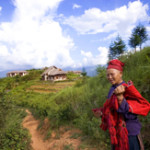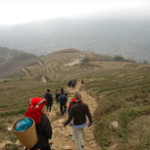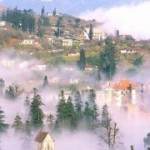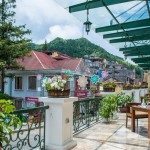Red Dragon Cruise and Yen Duc Village tour
Yen Duc Village is about 60km to the west of Halong Bay on the way from & to Hanoi. Yen Duc Village is a typical Vietnamese agricultural village which is rich in culture and traditions, it is also granted with beautiful landscape. The village is surrounded by the historical mountains which are mirrored themselves in the Kinh Thay river. Also, similar to other typical traditional Vietnamese village in the North of Vietnam, Yen Duc Village has charming golden rice fields in the harvest time, a lot of lakes and ponds, colorful garden, especially the ranges of areca trees in the sunshine.
Yen Duc Village has many historical monuments and a famous ancient pagoda named Canh Huong which contains cultural and historical values dated back to Ly and Tran dynasty. Over the years, the stories are still alive together with each famous mountain, river and pieces of land here.
In the village, all the alley roads are very clean with unique stone walls, especially the local villagers are very friendly, honest and extremely hospitable.
Joining a trip to Yen Duc village is a great chance to visit the charming fields, a holy pagoda, a historical site and other relic sites while wandering narrow alleyways in the odorous fresh air and talking with hospitable local people. With a convenience graphic location, Yen Duc Village is an ideal tourist site with unique experience for the customers after Halong Bay.
Historical Monument
Throughout the history of Vietnam, the war went through and left many historical sites. From the forests, rivers, cities… to the villages, the historical evidence of a heroic nation have been stored. Yen Duc village like many other villages in Vietnam, has contributed to the history of country. In the village, Canh Mountain and “73” cave stand as the spirit of heroic battle against the invaders. “73” cave dates back to the heroic struggle of 73 guerrillas, who sacrificed all for the freedom of people. Vietnamese people love peace but are so strong in protecting country, fighting against any invader. In the trip to Yen Duc village, visitors will pass through Canh Mountain, see the historical “73” cave and listen to the villagers’ stories about village and people.
Located in the Canh Mountain, “73” cave is the symbol of the local people’s courage and heroic sacrifices over the years.
By 1950s, Yen Duc village was invaded by the colonial enemy. However, they had difficulty in the countryside because of guerrilla fighters. The enemy underestimated the effectiveness of the Vietnamese guerrilla fighters because they used relatively simple weapons compared to the more advanced weapons of the enemy.
Understanding that, they could not fight again the enemy with the simple weapons while the enemy tried to destroy most of the Vietminh strongholds in the village, therefore the guerrilla fighters and local people disappeared in to the cave to hide themselves. The superior enemy’s weapons were useless against the guerrilla fighters who could not see.
The enemy found that, the guerilla fighters relied on local villages for food, water and other miscellaneous supplies. So to defeat them, the enemy needed to take away village support for the guerillas, and convince the Vietnamese people not to assist the guerrillas. On another hand, the enemy forced the local villagers to chop down the trees, destroyed the houses, the pagodas for fencing the cave.
In 6 days, the guerillas fighters were lack of food, water and weapon, they had to suffer from many difficulties and become tired while the enemy never stopped shooting and bombing into the cave, but the guerrilla fighters constantly tried to fight against.
On the 7th day, impatiently, the enemy used wood, straw and gas to fire the cave from all the entrances in order to kill all the hidden guerillas fighters and villagers. Facing the death, the guerillas fighters and villagers still showed no fear. They tried to fight against and hand in hand to sing all the songs about Vietnamese revolution and country by their last breath.
All 106 guerillas fighters and villagers were died inside the cave. Then, the enemy got into the cave to pulled 73 bodies out and buried them in the same hole.
In order to honor the merits of the guerillas fighters and villagers, either a memorial monument and a grave were built here in 1980 to dedicate the heroic local people who died in the war.
Local Houses
From ancient times, building house is one of life’s three big important things: buying buffalo, getting married, building house. With the concept has a good resident has good career innovation, that means stable accommodation then career is concerned; that the reasons why everyone tries to get their own house as particular property. The rural architecture of Vietnam houses is always synonymous with the village culture.
All houses are including the main house, the side (the horizontal, kitchen), barn, yard, garden, pond and fence, wall surround, gates. The main house is usually divided to parts by odd numbers (1, 3 or 5 part) and often turns to the south because of catching the sun when it’s cold and cool in the summer.
Almost houses have semicircle or circle pond in front – follow the “Feng Shui” theory. The pond is not only a place to growing fishes, snails but also all the daily activities taken place such as washing clothes, washing vegetables, washing dishes……..
All houses have an ancestor altar. Ancestor worship beliefs – worshiping the deadth is very popular in Asia, especially in Southeast Asia nations and particularly in the Vietnamese and Chinese culture. For Vietnamese, it’s almost become a religion.
It is always a garden surrounded by areca row in front and banana at the behind; the house – the garden creating the village with its law as a unified community and life has existed for thousands of year’s history.
Unlike the Western, Asian in general, and people in rural villages of Vietnam in particular tend to live three even four generations in the same house.
In Vietnam village, you are very easily to find items being made from things which are extremely familiar with normal life, such as: Areca fan; Coconut cup…
Local Houses
From ancient times, building house is one of life’s three big important things: buying buffalo, getting married, building house. With the concept has a good resident has good career innovation, that means stable accommodation then career is concerned; that the reasons why everyone tries to get their own house as particular property. The rural architecture of Vietnam houses is always synonymous with the village culture.
All houses are including the main house, the side (the horizontal, kitchen), barn, yard, garden, pond and fence, wall surround, gates. The main house is usually divided to parts by odd numbers (1, 3 or 5 part) and often turns to the south because of catching the sun when it’s cold and cool in the summer.
Almost houses have semicircle or circle pond in front – follow the “Feng Shui” theory. The pond is not only a place to growing fishes, snails but also all the daily activities taken place such as washing clothes, washing vegetables, washing dishes……..
All houses have an ancestor altar. Ancestor worship beliefs – worshiping the death is very popular in Asia, especially in Southeast Asia nations and particularly in the Vietnamese and Chinese culture. For Vietnamese, it’s almost become a religion.
It is always a garden surrounded by areca row in front and banana at the behind; the house – the garden creating the village with its law as a unified community and life has existed for thousands of year’s history.
Unlike the Western, Asian in general, and people in rural villages of Vietnam in particular tend to live three even four generations in the same house.
In Vietnam village, you are very easily to find items being made from things which are extremely familiar with normal life, such as: Areca fan; Coconut cup…
Quan Ho singing
Quan Ho folk song formed quite long ago by Viet people (Kinh people) in 49 Quan Ho villages and some other neighboring villages belong to Bac Giang and Bac Ninh province now created.
Quan Ho singing is a Vietnamese folk music style characterized both by its antiphonal nature, with alternating groups of female and male singers issuing musical challenges and responses, and by the fact that most of the songs in the repertoire deal with topics of love and sentimentality experienced by young adults.
The Quan Ho singing style originated in what is now Bac Ninh Province and was first recorded in the 13th century, and has traditionally been associated with the spring festivals that follow the celebration of Tet (the Vietnamese New Year). Historically, the singing began on the evening before the festival, but today it is much more common for the singing to occur on the main day of the festival.
According to the tradition, only young people used to sing Quan Ho songs, as the major body of song texts centers on the subject of love and sentimental desire among young adults. Nowadays, many elderly singers participate in the singing as well in response to the Quan Ho movement initiated by the provincial government. Originally, Quan Ho singing were exchange songs between two mandarins’ families. Gradually, it spread out and became popular among the northern people. Groups were formed just for singing, and many marriages were formed at these get-together. After centuries, it became the most significant Vietnamese folk-song type.
In general, an initial “challenge phrase” from the known body of songs is sung by a pair of female singers, following which a pair of male singers will respond by selecting and singing a “matching phrase”, which must repeat the melody of the challenge phrase. Once they are finished, the order is reversed, and the men will issue their own challenge phrase with a different melody. While in the past the singing was unaccompanied, it is common today for the singers to be accompanied by instruments, whether traditional Vietnamese instruments or modern ones such as electric keyboards.
There are a huge number of Quan Ho singing melodies, with thousands of different songs having been recorded and written down in score form.








